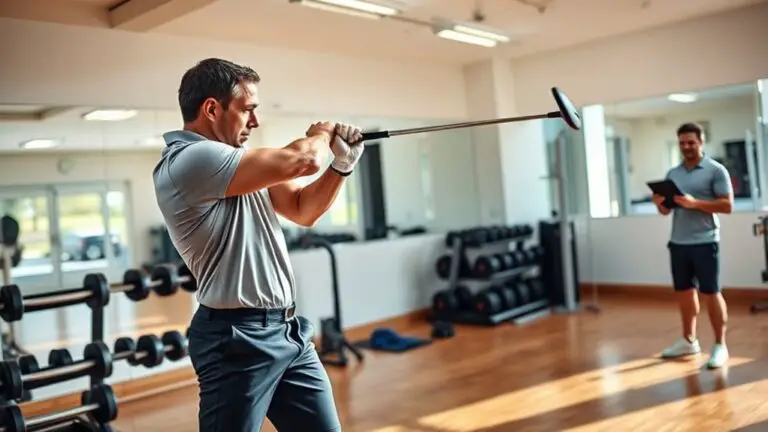How Box Jumps Can Enhance Strength and Power

Box jumps can greatly enhance your strength and explosive power by targeting key muscle groups and improving overall athleticism. By mastering jump mechanics—like engaging your core and coordinating your limbs—you’ll generate explosive force, increase your vertical leap, and boost speed. Regularly incorporating box jumps into your routine will enhance muscular endurance, agility, and coordination. As you progress, you’ll discover various techniques and variations that take your performance to the next level. There’s much more to explore!
Understanding the Mechanics of Box Jumps

When you’re tackling box jumps, understanding the mechanics behind them is vital for maximizing both strength and power. Start by focusing on jump mechanics: you want to generate explosive force from your legs. Begin with a solid stance, then engage your core and bend your knees as you prepare to leap. As you jump, extend your hips, knees, and ankles simultaneously, activating your glutes, quads, and calves. This coordinated muscle activation is essential for achieving maximum height and landing safely.
Pay attention to your arm movement, as they help propel you upward. Swing your arms back and then forward vigorously, aiding your lift. When you land, aim for soft knees to absorb impact, which will protect your joints and maintain balance. Practicing these mechanics not only improves your box jump performance but also enhances your overall athletic ability. Stay focused, and remember: mastering the mechanics leads to impressive gains!
Benefits of Box Jumps for Athletes
Box jumps offer a myriad of benefits for athletes looking to enhance their performance. This plyometric exercise targets multiple muscle groups, promoting the development of explosive strength vital for various sports. By incorporating box jumps into your training regimen, you can improve your power output, agility, and overall athleticism.
The dynamic movement requires coordination and balance, which translates into better performance on the field or court. As you master the technique, you’ll notice increased vertical leap and sprinting speed, essential attributes for any athlete.
Moreover, box jumps engage your core, improving stability and posture, further contributing to refined athlete performance. The high-intensity nature of this exercise also boosts cardiovascular endurance, helping you maintain energy levels throughout your training sessions.
Incorporating box jumps into your workouts is a strategic way to build strength and power, pushing you closer to achieving your athletic goals.
Building Explosive Power With Box Jumps

To build explosive power effectively, you need to focus on the mechanics of box jumps, as they engage fast-twitch muscle fibers critical for athletic performance. Start by maintaining a strong stance; your feet should be shoulder-width apart. As you initiate the jump, bend your knees and swing your arms back to gather momentum. This is where proper jump mechanics come into play. Explode upward, driving your knees toward your chest while propelling your arms forward. Land softly, absorbing the impact with your legs slightly bent to protect your joints and prepare for the next jump. By consistently practicing this movement, you’ll develop explosive strength that translates to improved performance in your sport. Incorporate box jumps into your training regimen 2-3 times a week, focusing on height and speed, and you’ll soon notice significant gains in your power output and overall athleticism.
Enhancing Muscular Endurance Through Plyometrics
Plyometric training isn’t just about building explosive power; it’s also key for enhancing muscular endurance. By incorporating techniques like repeated box jumps or depth jumps, you can considerably improve your stamina and overall performance. Let’s explore how these methods can elevate your endurance and keep you going strong in your workouts.
Benefits of Plyometric Training
While many athletes focus on strength and power, incorporating plyometric training into your regimen can greatly enhance muscular endurance. Plyometric benefits extend beyond explosive strength, as these dynamic exercises improve your muscle’s ability to sustain force over time. The training advantages of plyometrics involve increased energy efficiency and a heightened rate of force development. This means you’ll not only perform better in explosive movements but also maintain performance during extended activities. As your muscles adapt to the high-intensity demands of plyometric exercises, you’ll notice enhanced coordination and agility, which are vital for athletic performance. By integrating plyometrics, you’re setting the foundation for a more resilient and enduring physique, empowering you to excel in your sport.
Techniques for Muscular Endurance
Incorporating specific techniques can greatly boost your muscular endurance through plyometrics. To enhance your performance, focus on controlling jump intensity. Start with lower heights and gradually increase as your body adapts. This progressive approach helps manage muscle fatigue effectively while maximizing endurance gains. Incorporate circuits of repeated box jumps, aiming for higher repetitions with shorter rest periods. This method trains your muscles to withstand fatigue, improving overall stamina. Additionally, vary your jump patterns—mixing in lateral jumps or single-leg variations can challenge your stabilizers and promote balanced strength. Remember, consistency is key; regular practice will yield significant improvements in your muscular endurance. So, lace up those shoes and get ready to jump your way to enhanced performance!
Incorporating Box Jumps Into Your Workout Routine

When incorporating box jumps into your workout routine, mastering the proper technique is essential to prevent injury and maximize effectiveness. Start with foundational movements and gradually progress to more challenging variations as your strength and confidence grow. This strategic approach will enhance your overall performance and power output, making box jumps an invaluable addition to your training regimen.
Proper Technique Essentials
To maximize the benefits of box jumps, understanding and applying proper technique is essential for both safety and effectiveness. Start with your feet shoulder-width apart, and engage your core. As you initiate the jump, focus on your jumping form—use your arms for momentum by swinging them upward. Aim to explode off the ground, driving your knees toward your chest.
When landing, prioritize landing mechanics: aim for a soft, controlled landing with your knees slightly bent and feet flat on the box. This absorbs impact and reduces injury risk. Practice these techniques consistently; they’ll enhance your performance and build the strength and power you’re after. Remember, correct form is the foundation of successful box jumps, so perfect it before advancing.
Progression and Variations
Building on the proper technique you’ve mastered, adding progression and variations to your box jump routine can greatly enhance your strength and power. Start by experimenting with different box heights to challenge your explosiveness and engage various muscle fibers. Gradually increase your jump frequency to build endurance and improve overall performance. Here are some effective ways to incorporate progression and variations:
- Single-leg box jumps: Increase stability demands and target unilateral strength.
- Depth jumps: Boost power by jumping immediately after dropping from a height.
- Weighted box jumps: Add resistance to enhance strength further.
Safety Tips for Performing Box Jumps
Although box jumps can be an excellent exercise for enhancing strength and power, ensuring safety during the movement is essential to prevent injuries. First, always wear proper footwear that provides adequate grip and support. This helps stabilize your feet during the jump and landing, reducing the risk of slips. Before you start, incorporate warm-up routines that include dynamic stretches and mobility exercises for your legs and hips. This prepares your muscles and joints for the explosive movements involved in box jumps.
When performing the jump, focus on landing softly with your knees slightly bent to absorb the impact. Keep your core engaged and maintain a neutral spine throughout the movement. Start with a lower box height to master your form, and only progress to higher boxes as your confidence and technique improve. By following these safety tips, you’ll maximize your box jump performance while minimizing the risk of injury.
Progressing Your Box Jump Training

Mastering the fundamentals of box jumps is just the beginning; progressing your training is key to releasing greater strength and power. To elevate your performance, focus on technique refinement and gradually increasing your jump height. Here are some strategies to help you advance:
- Add Variations: Incorporate lateral jumps or single-leg box jumps to challenge your muscles in new ways.
- Increase Box Height: Once you’ve mastered a specific height, slowly progress to taller boxes, ensuring your form remains solid.
- Track Your Progress: Keep a training log to monitor your jump height and technique improvements, which will help you stay motivated.
Frequently Asked Questions
What Type of Box Is Best for Box Jumps?
When choosing a box for box jumps, consider using plyometric boxes designed for stability and safety. The box height should match your skill level; beginners might start with a lower height, around 12-18 inches, while more advanced athletes can progress to 24-30 inches. Always guarantee the box is sturdy and won’t wobble during your jumps. By selecting the right box, you’ll maximize your performance and minimize the risk of injury.
How Often Should I Perform Box Jumps?
Imagine your training schedule’s like a well-tuned engine; if you push it too hard, it stalls. For box jump frequency, aim for 1-3 times a week. This balance allows your muscles to recover and grow stronger without risking injury. Incorporate them into your lower body workouts or plyometric sessions. Remember, consistency’s key, but so is listening to your body. So, keep that engine running smoothly, and watch your progress soar!
Can Beginners Do Box Jumps Safely?
Absolutely, beginners can do box jumps safely if they follow some key techniques and safety precautions. Start with a lower box height to build confidence and proper form. Focus on landing softly with your knees slightly bent to absorb impact. Gradually increase the height as you improve. Always warm up beforehand and consider having a trainer guide you initially. With patience and practice, you’ll master box jumps while minimizing the risk of injury.
Are There Alternatives to Box Jumps?
Absolutely, there are plenty of alternatives to box jumps. You can incorporate step-up variations, which target similar muscle groups without the impact. Plyometric exercises like jump squats or burpees can also enhance your explosiveness and agility. These alternatives allow you to build strength while reducing the risk of injury. Don’t hesitate to mix things up; it keeps your workouts engaging and helps you progress effectively. Keep pushing your limits!
What Shoes Are Best for Box Jumps?
Did you know that over 70% of athletes experience improved performance with the right footwear? When you’re choosing shoes for box jumps, look for options that offer excellent shoe traction and foot stability. This helps prevent slips and provides a solid base for explosive movements. Shoes designed for agility training or cross-training often feature these qualities. Investing in the right footwear can enhance your workout and boost your confidence during high-intensity training sessions.





